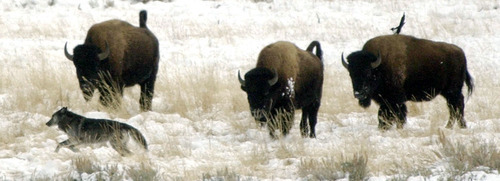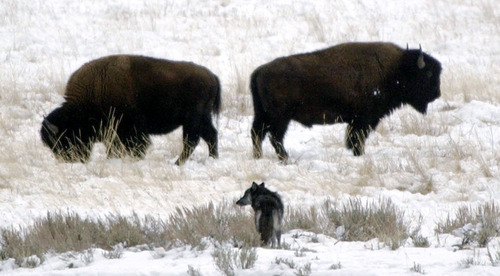This is an archived article that was published on sltrib.com in 2011, and information in the article may be outdated. It is provided only for personal research purposes and may not be reprinted.
A few weeks ago Yellowstone National Park officials discovered the carcass of one of the park's deadliest wolves, an aging male that scientists knew to be an aggressive bison hunter.
Wolf No. 495 died naturally, but his body bore bruises consistent with injuries inflicted in an encounter with large game, according to Dan MacNulty, an assistant professor of wildlife ecology at Utah State University.
The wounds found on No. 495 help explain MacNulty's latest findings that wolves' hunting success bears little correlation to the size of the hunting party beyond four wolves. Wolves hunt in groups because taking down large hoofed animals is not only challenging but dangerous.
But if the attack party exceeds four animals, the chance of success levels off, according to research MacNulty and colleagues published this week in the journal Behavioral Ecology.
"Wolves aren't as effective hunters as we think they are. That perception is premised on the notion that each individual contributes to the hunt, so there is an additive effect when the group is bigger. That is just not the case," said MacNulty, an assistant professor of wildland resources. "Individuals are responding to the threat of injury and death that large prey poses, so they are pulling back, making decisions to avoid the cost of injury."
The new research is based on eight years of observations in Yellowstone's Northern Range involving 94 wolves from five packs, including the late No. 495 from Mollie's pack.
Once eradicated from the Northern Rockies, wolves were reintroduced at Yellowstone in 1995. These animals and their descendants are among the most closely studied populations in the world. The observations track behavior of individual animals over the course of their lives, creating a powerful data set for understanding this controversial social predator.
The findings suggest group hunting is not the main reason wolves live in packs, according to co-author David Mech of the U.S. Geological Survey's Northern Prairie Wildlife Research Center. "Looking to lions and other social predators, it provides further insight into the evolution of living in groups," he said.
Hunting is a four-stage process for wolves that grows increasingly dangerous. First the group approaches a prey herd, then chases it and singles out an individual before taking it down.
MacNulty's data tracked how many wolves were involved at each stage of particular elk hunts and their outcomes. But his team also knew a lot about each wolf involved, which gave the team insights into wolf behavior.
"We knew the gender, the age, whether they were breeding," said MacNulty. "Parents generally take the lead because they have offspring to provide for. … Given a choice, wolves will stay out of harm's way until it's safe to enjoy the spoils of the hunt. They're opportunists. And this challenges the popular belief that wolves are highly cooperative hunters."
MacNulty has been involved with the Yellowstone Wolf Project from its inception. Co-author Doug Smith, of the National Park Service, leads the program and conducted some observations aerially, although most were done on the ground by volunteers.
"Our findings may not be true of larger prey. Wolves are throwing the kitchen sink at bison," Smith cautioned.
Real wolves bear almost no resemblance to their fairy-tale caricatures. In previous research, MacNulty demonstrated that wolves' hunting prowess peaks at age two or three, then declines rapidly. These archetypal killers aren't well-built for killing big prey anyway.
Cougars' claws and powerful forelimbs are not only effective tools on large prey, but also enable the predator to kill without being killed. By contrast, wolves' tools are teeth and jaws, but to put them to use, they must expose themselves to serious harm.
"Wolves are risk averse. They are cautious hunters," MacNulty said. "Hunting success also peaks in small groups with other social predators. But our study is the first to rigorously test this pattern and demonstrate that it's likely due to individuals switching from cooperation to 'free riding' as group size increases."







